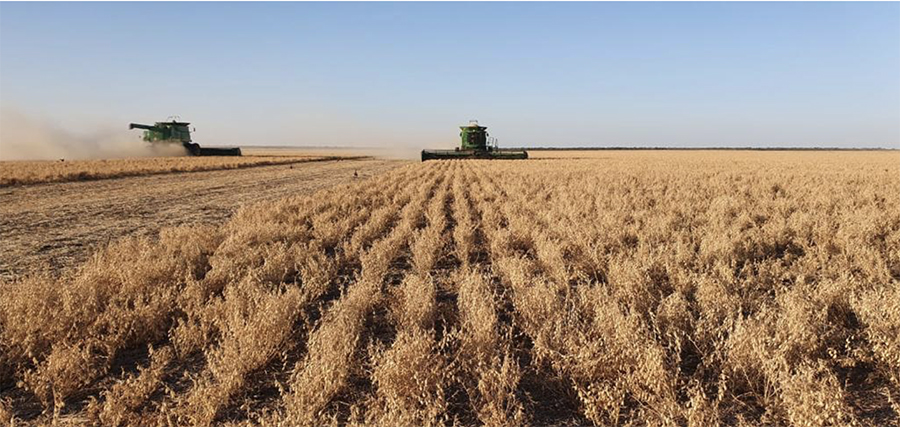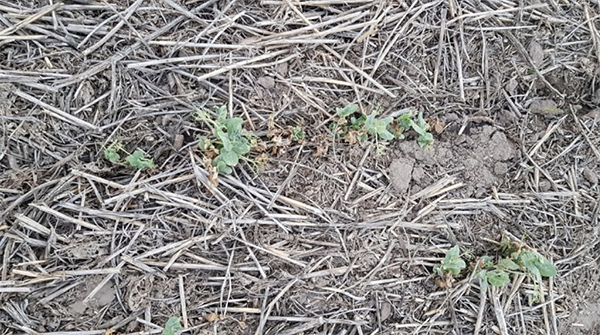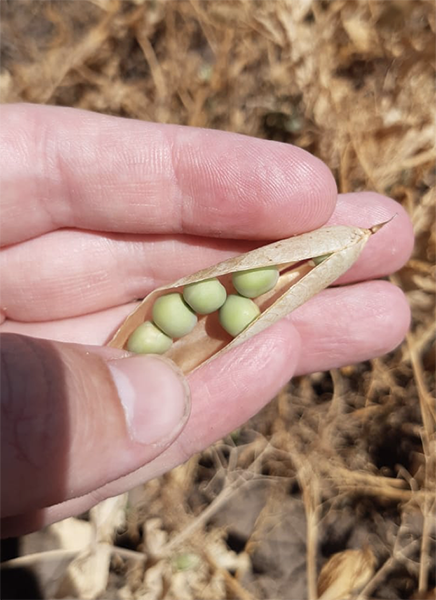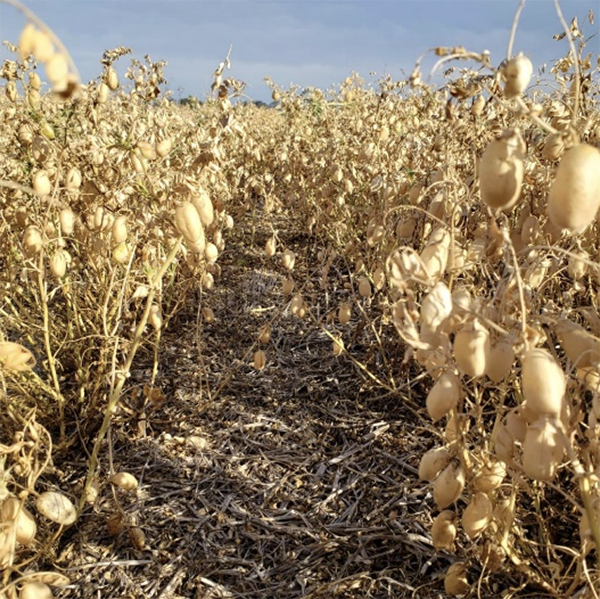December 29, 2020
Just as with the bean crop earlier this year, dry conditions and freezing temperatures knocked down the yields of the country’s chickpea and dry pea crops.


Photo courtesy Desdelsur.
This has not been a fruitful year for Argentina’s pulse growers. Back in June, the dry bean harvest was marked by subpar yields and smaller grain sizes. Now, with the harvest of its winter pulse crops complete, it is clear that the country’s dry pea and chickpea crops fared no better, and maybe even worse.
The sting is particularly painful for the dry pea sector, which had seen the crop go into the ground with much grower enthusiasm on attractive prices at levels last seen in 2013.
“We contracted with a lot of growers who were enthusiastic about seeding peas as an alternative to wheat because it looked like wheat prices were going to decrease at planting,” says Ingrid Renzone of Ronalb, one of Argentina’s leading pea processors and exporters. “Now with the yields we are seeing this year, it won’t be easy to get them excited about seeding peas again in 2021.”
The chickpea sector, on the other hand, saw low prices drive the seeded area down by about 60% on the year; the low yields now further restrict the availability of product for MY 2020/21.
Below we take a closer look at the production and market conditions for both crops.

Photo courtesy Ronalb.
Argentina’s dry pea production is comprised mainly of green peas, with yellow peas accounting for maybe a fifth of the crop. The growing area is largely concentrated in southern Santa Fe province and adjoining northeast Buenos Aires province. Smaller volumes are also produced in central and western Santa Fe, western Entre Rios province, and central and western Buenos Aires province.
Every year, Gabriel Prieto, chief of INTA’s (Argentina’s National Agricultural Technology Institute) Arroyo Seco extension agency, conducts a tour of the main growing area (southern Santa Fe and northeastern Buenos Aires). This year, he estimates 70,000 ha. were seeded to peas there, with northeastern Buenos Aires accounting for 70% of the total area. Including the minor production areas, he believes it is possible that Argentina seeded a total of 85,000 – 100,000 ha. to dry peas this year.
At Agrofin Agrocommodities, Lucas Genero estimates the green pea area alone at 70 – 75,000 MT. The yellow pea area, he explains, is difficult to determine, as many growers plant yellow peas as feed for their livestock and therefore do not report it; however, if international prices are attractive at harvest, they then turn around and sell their crop for export.
The story of the 2020 dry pea growing season is a tale of two provinces: Buenos Aires and Santa Fe. Pea crops in both areas had to contend with some weather challenges, but to vastly different degrees. The biggest factor was the dry conditions.
“Precipitation was at historic lows,” says Prieto. “Some places got no more than 550 mm of rain. That’s something we haven’t seen since 1920.”
Additionally, the crop was hit by a series of frost events, including one just as the pea plants were nearing the reproductive stage. Then, in mid-October, the crop was hit by abnormally high temperatures that saw the mercury rise as high as 38 ? C in Santa Fe.
“Santa Fe got the worst of all three weather phenomena,” says Prieto. “Dry conditions, frost and then heat.”
Ronalb, one of Argentina’s top green pea processors and exporters, works with growers in the southern Santa Fe area. Company manger Ingrid Renzone says that the heat was devastating, affecting 90% of the company’s green pea fields in Santa Fe and Entre Rios.
“It got to be a joke because when we looked at the satellite images, we saw that the rain this year always passed through the same area in central Buenos Aires. All the rain went through there, and here in Santa Fe we didn’t get any at all.”
Consequently, Santa Fe harvested its pea crop early, while Buenos Aires lagged a bit due to minor rain delays. By about the first week of December, the pea harvest was completed. In Santa Fe, Renzone reports yields of between 500-800 kg/ha.
“At Ronalb, we harvested all our fields, but many growers decided not to bother with fields that were yielding 400 kg/ha. or less,” she reports.
Over in Buenos Aires, Genero reports yields of 1,500 – 2,000 kg/ha. in the areas north of the municipality of Pergamino, and 2,500 – 3,000 kg/ha. in the areas to the south.
“The farther north you go, the lower the yields,” Genero sums up.
Given that Buenos Aires seeded more peas this year than Santa Fe, Prieto estimates the average yield for the crop as a whole at 1,800 kg/ha. and calculates total production of 150,000 – 160,000 MT at a minimum and 180,000 MT on the high end. Genero estimates green pea production alone at 140,000 – 150,000 MT, with most of it concentrated in Buenos Aires province. Renzone, however, is skeptical that production ended up being that much; she believes the true number is closer to 100,000 MT.
“Not all of the Buenos Aires crop was good either,” she says. “I would say that if you look at the seeded area as a whole, 60% or more yielded less than 1,000 kg/ha.”
On the flip side, although production took a hit, the dry conditions at harvest resulted in a good quality green pea crop. Due to the lack of moisture, disease and weed issues were not a factor and the incidence of bleaching, spotting and splitting is low, explains Prieto. Genero estimates 70-80% of the crop is of good to very good quality. In the areas where it rained the least, though, the grain size is smaller than normal, says Renzone.
“One of the issues with Argentina’s pea production is that about 70% of what is planted is of a variety that has been on the market for 27 years now,” adds Prieto. “Its genetic integrity has deteriorated. That variety produces a relatively small grain size to begin with, and with the drought conditions in Santa Fe, it was even smaller than you would typically expect.”

Photo courtesy Agrofin.
Argentina’s chickpea production is almost exclusively of the kabuli variety. According to Matias Macera of Desdelsur, one of the country’s leading chickpea processors and exporters, desi chickpeas account for about 3% of this year’s crop.
The province of Cordoba is Argentina’s traditional chickpea growing area. Chickpeas are also grown in neighboring San Luis province and in a region referred to as the NOA (noroeste argentino, or northwest Argentina) that encompasses the provinces of Jujuy, Salta, Tucumán, Catamarca, La Rioja and Santiago del Estero.
As with its pea crops, Argentina’s 2020 chickpea production was curtailed significantly by drought and frost events. A December 14 report from the Cordoba Grain Exchange paints a brutal picture. It estimates the area seeded to chickpeas in Cordoba at 17,800 ha., down 61% from last year, and the harvested area at 14,500 ha. Production is estimated at 19,800 MT, a 68% decrease from last year.
But Lucas Genero, whose company Agrofin works with chickpea growers in Cordoba, disagrees with those figures. He estimates Argentina seeded 50,000 – 60,000 ha. of chickpeas this year, with 60% planted in Cordoba and San Luis, and 40% planted in the NOA.
“We seeded about 30-40% fewer chickpeas this year than last year because of the dry winter we had, and the soil moisture levels,” he says. “A lot of the area went unseeded because of the lack of water.”
At Desdelsur, Macera’s seeded area estimate is similar. He believes Argentina seeded 50,000 ha. to chickpeas, but by his reckoning the NOA accounts for 30,000 – 35,000 ha. of that total and Cordoba only about 25,000 ha. Not all of the seeded area was harvested, however.
“Because of the dry conditions, there were fields with yields of 300 kg/ha. or less, and growers didn’t bother to combine them,” says Macera. Considering just the harvested area, he pegs the average yield in the NOA at 650 kg/ha. However, nearly 7,000 ha. of the chickpea area in the NOA is irrigated, and in those fields yields averaged 2,250 kg/ha.
In Cordoba and neighboring San Luis, Genero estimates chickpea crops seeded in dryland yielded 1,000 – 1,500 kg/ha., while those seeded in irrigated fields saw yields of 2,000 – 2,500 kg/ha. In a normal year, he notes, irrigated chickpea fields would yield at least 3,000 kg./ha. Overall, he pegs the average yield at 1,700 – 1,800 kg/ha.
Based on his calculations, Genero estimates Argentina’s 2020 chickpea crop at 60,000 – 70,000 MT. Macera places the size of the crop at a more modest 55,000 MT.
“Estimating the production of the chickpea crop is a challenge,” Genero admits. “Unlike other pulse crops, the growing area is spread out and we are often surprised by areas that emerge and that we hadn’t accounted for. Organizations like CLERA (Argentina’s Chamber of Pulses) are helping to improve our estimates.”
Just like with the pea crop, the dry conditions resulted in a good quality chickpea crop, although the caliber size distribution is on the small side. In the NOA, Macera reports that 60% of the chickpeas grown on dryland were 7 mm in size, while 30% were 8 mm and 10% were 6 mm in size. On irrigated fields, the caliber distribution was 20% of 9 mm chickpeas, 50% of 8 mm and 30% of 7 mm. In Cordoba, Genero reports that Agrofin’s plant is receiving 30% 9 mm chickpeas, 60% 8 mm and 10% 7 mm.

Photo courtesy of Agrofin.
Although in recent years Argentina’s pulse industry has made modest inroads in increasing pulse consumption, beef continues to be the nation’s predominate protein source.
“In supermarkets we have seen a noticeable increase in pulse consumption,” says Prieto. “In part this is because pulses are a more affordable source of protein than meat, and meat prices have increased greatly. Some people are also cutting back on meat consumption for ideological reasons.”
Lentils are the only pulse that Argentines consume in significant volumes. Macera estimates Argentines consume 30,000 MT of lentils a year. In terms of dry pea consumption, Genero estimates that Argentina’s domestic demand typically amounts to 5,000 – 10,000 MT per year, most of it coming from the country’s canning industry. Typical annual chickpea demand, according to Macera, totals about 5,000 MT. A good part of that, informs Genero, is used to make farinata for the pizzerias of the capital city of Buenos Aires, which have the idiosyncratic custom of serving it together with pizza.
But when the COVID-19 pandemic spread into Argentina in March, domestic pulse consumption levels skyrocketed. This was mainly due to government buying for food assistance programs, although there was also greater demand from supermarkets and from NGOs dedicated to helping the most vulnerable. Initially, the government’s pulse procurement was focused on lentils, but available inventories soon ran out and interest then turned to other affordable alternatives, namely green peas and chickpeas.
“Pulses are a good fit for government food assistance programs because of their nutritional value and affordable prices,” says Macera.
Genero estimates government buying at the federal, provincial and municipal levels took 15,000 MT of split and whole green peas and 10,000 MT of chickpeas in 2020. That elevated domestic consumption to 15,000 – 25,000 MT for peas and about 15,000 MT for chickpeas. Genero reports that the government has issued tenders for 2021 and he therefore expects to see domestic demand at similar levels in the new year. Macera agrees.
“We have to see what happens with the pandemic. Perhaps we won’t quite see 10,000 MT of chickpeas go to the domestic market, but I don’t see it returning to pre-COVID levels either,” Macera opines. “The government support for the most vulnerable will continue to be there because the socio-economic aftereffects of this public health crisis will continue to be felt for several years to come.”
Meanwhile, regardless of the pandemic, domestic consumption continues to trend upward. Macera points to the emergence of locally made hummus products as an example of growing internal consumption in the chickpea sector.
“It is still a small niche market, but we may see a slight increase in internal demand because of it,” he says.
Argentina enters the 2020/21 marketing year with nearly zero carry-in for both peas and chickpeas.
In MY 2019/20 (November-October), Argentina exported about 46,000 MT of green peas and 162,000 MT of chickpeas. The top markets for green peas were Brazil (48%), the west coast of Africa, namely Senegal and Gambia (20%), Russia (12%), Chile (7%) and Italy (4%). The top markets for chickpeas were Pakistan (24%), Chile (22%), Italy (12%), Colombia (6%), Spain (6%) and India (6%).
“Chile was a surprise,” says Macera. “The boost in chickpea demand there came primarily from government purchases to address the COVID-19 pandemic.”
For MY 2020/21, then, Argentina’s pea and chickpea sectors will depend solely on this year’s production. By Genero’s estimation, after discounting seed and waste and accounting for domestic demand, Argentina has about 100,000 MT of green peas and 45,000 – 55,000 MT of chickpeas available for export. Macera believes the exportable chickpea supply is 45,000 – 50,000 MT.
Peas
On the export outlook for new crop green peas, Renzone reports that there is firm demand from traditional buyers, which she finds a bit surprising giving the availability of lower priced product in Canada. Demand from Brazil, notes Genero, is particularly strong due to increased pandemic-related consumption there and poor domestic production due to drought. He expects the other usual buyers, including west Africa, Russia and Italy, to take their normal share, which, by his calculations, would leave Argentina with 40,000 – 50,000 MT of green peas in search of a home.
Renzone says new crop green pea prices stand at $400 MT FOB. Genero places them in the $400 - $420 range and expects prices to remain steady. At these levels, domestic market prices are more favorable to growers. Government tenders are paying farmers $300 per MT for unprocessed product, while exporters cannot pay more than $230 if they are to make a profit at current international prices. Additionally, many growers are holding onto their pea crops as a form of financial reserve since peas are sure to preserve their value more so than the Argentine peso as the country traverses a financial crisis exacerbated by the pandemic.
“We have twice as much production as last year,” says Genero. “But with this pandemic, no one knows if that is too much or too little. We have the experience of 2020, but who knows what will happen with COVID-19 in 2021.”
With respect to yellow peas, the recent finalization of a trade agreement with China has created an opportunity for Argentina’s production, but the sector has yet to produce the volume necessary to be competitive against product from North America.
“The yellow pea market is a high-volume market,” explains Renzone. “You need to have a reliable buyer lined up and for that you need to have the volume. At the same time, in order to convince growers to produce that volume, you need to have a reliable buyer lined up. So, we are stuck in a vicious circle.”
An excessive tax burden is also keeping Argentina’s yellow pea exports from being competitive, she adds.
Chickpeas
Macera reports that demand for Argentine chickpeas is quiet at the moment. He attributes the slow movement to closures in the food service sector as a result of the COVID-19 pandemic. While the pandemic led to a spike in chickpea demand from canners and packagers, it also saw restaurants and hotels close, and social events like weddings postponed.
“There is a lot of uncertainty in the sector. Will they open or remain closed?” he says. “I think its because of the impact on food service that chickpea prices didn’t increase to the same degree as prices did for other pulses. I think that when the pandemic eases and restaurants and hotels reopen, when people start holding social gatherings again, then demand will return.”
At Agrofin, Genero concurs with Macera that movement is slow at the moment. He notes that in North America, the U.S. and Canada have 600,000 – 800,000 MT of kabuli chickpeas between them.
“They drive the market,” he says. “And because of the low yields we got this year, growers are unwilling to sell at a loss, and we can’t compete with prices out of North America.”
Genero sees a chance for international prices to improve and exports to pick up in February or March, depending on production in Mexico.
Additionally, in the domestic market the government is presently focused on buying split peas and has not yet issued tenders for chickpeas.
“They will eventually, but they haven’t yet,” says Genero.

Argentina / Santa Fe / Entre Rios / Buenos Aires / Jujuy / Salta / Tucumán / Catamarca / La Rioja / Santiago del Estero / Ingrid Renzone / Gabriel Prieto / Matias Macera / Lucas Genero
Disclaimer: The opinions or views expressed in this publication are those of the authors or quoted persons. They do not purport to reflect the opinions or views of the Global Pulse Confederation or its members.